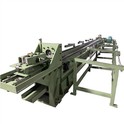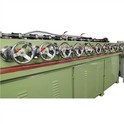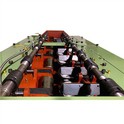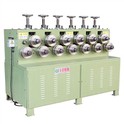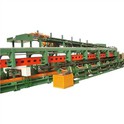Cutting Machine
Why Choose Us?
Rich Experience
"FANGRONG" brand established in 1998, we are the leader of straightening machine, drawing machine, and pointing machine in China.
Wide Range of Applications
We have rich experiences in aluminum industry, copper industry, stainless steel industry, titanium alloy industry, magnesium alloy industry, molybdenum alloy industry, lead alloy industry, set.
Reliable Product Quality
Our company has been providing customers with better quality products. Our business is always customer-oriented and focuses on creating customer service experience.
Excellent Customer Service
Our goal is to make professional first-class equipment, first-class service and first-class innovation, and realize product specialization, technology specialization, service specialization and teamwork.
What is Cutting Machine?
A cutting machine, also known as a cutter, is a device that uses a blade or tool to cut through materials such as metal, wood, fabric, plastic, and paper. These machines are equipped with mechanisms to control the movement of the blade, ensuring precise cuts at desired angles and shapes. Cutting machines are widely used in industries like automotive, aerospace, construction, textiles, packaging, and electronics. There are several types of cutting machines available in the market, each designed for specific material and application.
Advantages of Cutting Machine
Eases the Task
Grinding a steel rod by hand takes a long time and is exhausting. A steel bar cutting machine, on the other hand, helps to eliminate it by continuously cutting steel bars into various sizes and pieces. It allows contractors to continue working on the project instead of waiting for hours for steel bars to be cut to the correct size and dimensions.
Fewer Errors
The majority of steel bar cutting machines have simple settings that allow the operator to specify the appropriate cutting length. The feature ensures that all steel bars are cut to the exact length required, with minimal to no errors. This capability is particularly useful in the construction of buildings and bridges that require precise steel measurements. In a construction site minimal errors are an added bonus.
Fine Machinery Parts
Cutting through steel needs a lot of torque. If the parts of the machine are not lubricated, it can result in wear off or break down. To help reduce friction, heat, wear, and tear, most of the manufacturers utilise oil-bathed, fine machinery. It not only results in blades running better, but also extends the life of a steel bar cutting machine.
Easy to Use
A steel bar cutting machine is very simple to use. Most manufacturers of these machines incorporate foot pedals and finger-operated controls. It makes cutting and bending extremely accurate and safe. Anyone can learn how to run the machine efficiently without jeopardizing anything in only 30 minutes. The user-friendly interface makes it simple for contractors to cut and shape rods.
Low Power Consumption
One common belief is that a steel bar cutting machine requires a lot of energy to run. That is not true. Cutting steel bars with these machines consumes relatively little energy. It is partly due to the electric engine’s increased power, and its specifically designed and produced blades that easily cut through steel.
Application of Cutting Machine
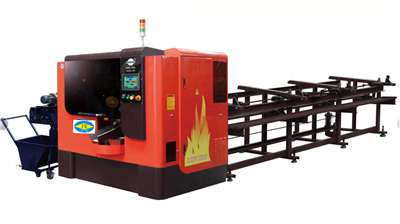



Automotive industry
Cutting machines play a crucial role in the automotive industry, where precision cuts and complex shapes are required for various components. From body panels and chassis parts to exhaust systems and interior components, cutting machines enable efficient and accurate fabrication.
Aerospace industry
In the aerospace industry, where lightweight materials and intricate designs are the norm, cutting machines excel at creating precise contours and complex shapes. These machines are used in the production of aircraft components, including wing structures, cabin interiors, and engine parts.
Electronics industry
Cutting machines are extensively used in the electronics industry, where intricate and miniaturized components are in high demand. These machines can cut delicate materials, such as circuit boards, thin films, and semiconductors, with exceptional precision and minimal heat-affected zones.
Architecture and construction
Cutting machines have revolutionized the architectural and construction sectors by enabling the fabrication of intricate and unique designs. From metal and glass panels to decorative elements and signage, these machines allow for precise cutting, engraving, and etching on a variety of materials.
Medical industry
Cutting machines have become indispensable in the medical industry for the precise fabrication of medical devices and instruments. These machines are used for cutting thin materials, such as surgical instruments, stents, and implants, with exceptional accuracy and minimal thermal damage.
Components of Cutting Machine
Fiber laser
Lasers are the “power source” of the core of laser equipment, just like automotive engines, and are expensive components in cutting machines.
Cutting head
The cutting head is a laser output device of a cutting machine, which is composed of a nozzle, a focusing lens and a focus tracking system. The cutting head of the cutting machine will walk according to the set cutting trajectory, but the height of the laser cutting head needs to be adjusted and controlled under different materials, different thicknesses and different cutting methods.
CNC system
The control system is the leading operating system of the cutting machine, which mainly controls the machine tool to realize the movement of the X, Y and Z axes, and also controls the output power of the laser. Its quality determines the stability of the operation performance of the cutting machine, and the cutting effect can improve by software control.
The motor
The motor of the cutting machine is the core component of the motion system. The performance of the motor directly affects the processing effect and production efficiency of the product. At present, the commonly used motors include stepping motor and servo motor, which are configure according to the industry type and product type of the processing object. Suitable motor.
Machine Bed
Mostly cutting machines have very high requirements for machine tool stability. So at present, mainstream machine tools on the market include gantry, cantilever, beam, etc. Different machine tools have different functions. For example, beam type machine tools are mainly use for material cutting by large manufacturers.
Laser lens
Laser lenses are use in the whole fiber laser cutting equipment. Many optical devices contain laser lenses. Different lenses have different functions, such as full-reverse lenses, semi-reverse lenses, and focusing lenses.
Step 1: First of all find a suitable space to set up the machine, so as to avoid any safety hazards or accidents.
Step 2: Read a safety checklist thoroughly before using the machine. Follow all the precautions, mentioned in the checklist. Make sure you stand away from the machine when using it.
Step 3: After placing the machine, connect it with a stable source of electricity. Make sure that the wires are properly covered and no one can trip on them. Carefully pour oil into the oil opening.
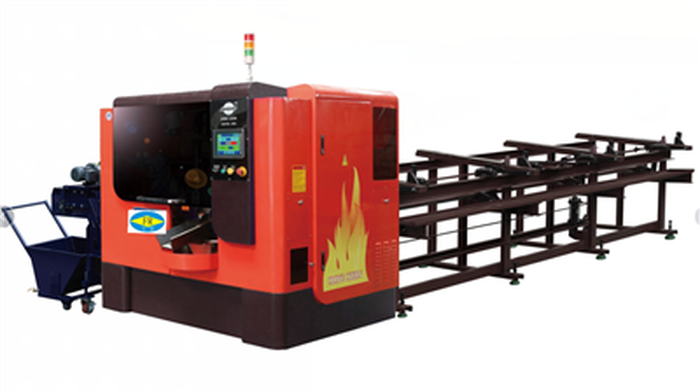

Step 4: A long stick-type handle, located on the side of the machine, is known as a cutting clutch. It moves the blade every time you pull it. Adjust the cutting clutch to your desired length to control the cutting process.
Step 5: Mark your bars at points you want to cut before you start cutting them. Now, safely place the steel bar inside the U-shaped grip and stand at least 2 feet away.
Step 6: Pull the cutting clutch. The moveable blade will slide towards the fixed blade and cut the bar in between. The motor gives enough energy to the blade to cut through the bar easily.
Step 7: Repeat the same process again while cutting the bar/s next time.
Maintenance Tips for Cutting Machine
Lubrication
Lubrication is one of the most important maintenance steps. That’s because proper lubrication ensures a smooth operation and reduces wear on moving parts. An unlubricated cutting machine can quickly damage itself and may not be as efficient or precise as a well-oiled machine. To lubricate, you should follow the manufacturer’s instructions. However, this normally involves turning the power completely off, cleaning the guide rail, and applying the proper lubricant to the guide rail before running the machine to lubricate all areas. turn the power completely off and clean the guide rail with.
Cleaning Mirrors and Lens
You should clean the mirrors and laser lens often. The optic mirrors and lenses can become dirty from dust, debris, moisture, smoke, and other contaminants. This can change the laser reflection rate, potentially damaging other components. Remove the laser head, divide the components, and use a soft swab to clean both sides of the lens carefully and methodically. If necessary, you can use warm water or a cleaner designed for this purpose. Then, remove any residue with a dry, scratch-resistant cloth.
Cleaning Other Components
In addition to the mirrors and lens, you also need to clean the exhaust fan, tube filter, and nozzles. All of these parts can become quite dirty after use and could become a potential safety hazard to your machine or operator. To clean the fan, remove the cover and wipe all dust from the blades with a brush or compressed air. To clean the tube filter, remove it and then use a low-pressure vacuum cleaner. Wipe down nozzles daily to ensure precise cutting.
Replacing Worn Parts
Make sure you check all laser-cutting machine parts regularly. Then, if they are worn out they should be replaced as soon as possible. This is not only good for prolonging laser cutting equipment life, but also for optimal performance. While checking parts, you should also make sure the software doesn’t need an update if you’re using a computer-controlled cutting machine like the powerful, easy-to-use, and extremely precise cutting machine. Finally, you should check alignment during this process. To help you out, here’s a cutting machine maintenance and inspection checklis
Mild Steel
Mild steel is a type of carbon steel with a low carbon content it is also referred to as “low carbon steel”. The carbon content of mild steel is typically 0.05% to 0.25% by weight, whereas higher carbon steels have a carbon content ranging from 0.30% to 2.0%. When more carbon is added, the steel seems to become cast iron. Some of these Mild steel where it is used in: Structural steel, Signs, Automobiles, Furniture, Decorations, Wire Fencing.
High Tensile Steel
The term “high tensile” refers to the steel’s resistance to deformation when a force is applied to it. This makes it ideal for use in construction and other applications where high levels of stress will be applied to the steel. High-tensile steel is frequently used in the construction of bridges, buildings, and other structures, as well as the production of vehicles, machinery, and tools. High-tensile steels can be treated and cooled down to achieve a stronger hardness than other steels. At certain stress levels, the high tensile property is responsible for steel’s tension resistance, high yield, and fatigue strengths.

Dos and Don’ts of Cutting Machine
Dos
Inspect the Machine: Conduct a thorough inspection of the bar cutting machine before each use. Check for any visible damage, loose or missing parts, and ensure that all safety features are functional. Never operate a machine that appears faulty or damaged. Report any issues to the supervisor or maintenance personnel immediately.
Secure the Workpiece: Properly use clamps or vices to prevent movement during cutting. This ensures accurate and safe cutting and minimizes the risk of injury. Do not attempt to cut unsupported or loose material, as it may lead to dangerous situations.
Use the Correct Cutting Tools: Select the appropriate cutting tool for the specific type and diameter of the steel bars you work with. Using the wrong tool can result in inefficient cutting, increased wear on the machine, and potential damage to the tool or workpiece. Follow the manufacturer’s recommendations regarding tool selection.
Wear Personal Protective Equipment (PPE): Always wear appropriate personal protective equipment, including safety goggles, ear protection, gloves, and steel-toed boots, when operating a bar cutting machine. These precautions will protect you from hazards such as flying debris, loud noise, and accidental contact with sharp edges.
Don’ts
Force the Cutting Process: Let the machine do the work. Do not exert excessive force or pressure on the cutting tool, as it can cause damage to the machine, reduce cutting precision, and potentially lead to accidents. Allow the machine to operate at its designed speed and power, and avoid unnecessary stress on the tool or workpiece.
Neglect Machine Maintenance: Regularly inspect and maintain the bar cutting machine per the manufacturer’s instructions. Follow the recommended schedule for lubrication, blade replacement, and general upkeep. Neglecting maintenance can lead to decreased performance, increased wear and tear, and potential safety hazards.
Ignore Emergency Stop Function: Familiarize yourself with the location and operation of the emergency stop button on the machine. In case of an emergency or hazardous situation, immediately press the stop button to halt the operation. Ignoring or forgetting this safety feature can have severe consequences.
Overload the Machine: Avoid exceeding the machine’s cutting capacity. Each bar cutting machine has a maximum cutting capacity specified by the manufacturer. Exceeding this limit can strain the machine, decrease cutting accuracy, and pose a safety risk. Always adhere to the recommended guidelines for maximum load capacity.
How to Choose the Perfect Cutting Machine for Your Needs
Define your needs
Identify what you need the cutting machine for, including the type of materials you will be cutting, the size of the materials, the precision required, and the volume of production. This will help you narrow down your choices and find a machine that meets your specific requirements.
Consider the cost
Determine your budget and explore various options within your budget. Don't just look at the initial cost of the machine but also consider ongoing costs like maintenance, consumables, and operating costs. Compare different machines and their cost-effectiveness to find the best value for your money.
Look at the features and capabilities
Research different cutting machines and their features, capabilities, and technical specifications. Consider factors like cutting speed, accuracy, material types, and any additional features that could enhance your production process, such as automation or integration with other machines or software.
Read reviews and check references
Look for independent reviews and comparisons of different cutting machines to get a better understanding of their performance and reliability. Also, contact manufacturers or suppliers to ask for references or examples of previous customers who have similar needs to yours.
Consider durability and reliability
The durability and reliability of the cutting machine are crucial factors to consider. Machines that are built to last and can withstand regular use are more cost-effective in the long run. Look for machines that are made of high-quality materials and have a good reputation for durability and reliability.
Think about operator comfort
The ergonomics and comfort of the operator are important considerations. Make sure the machine is easy to operate, has good visibility, and has features that minimize operator fatigue or discomfort during extended use.
Consider after-sales service
The availability of after-sales service and support is crucial for maintaining the performance and longevity of your cutting machine. Make sure to choose a manufacturer or supplier that offers reliable support, including parts replacement, repairs, and training services.
Our Factory
Dongguan Fangrong Precision Machinery Industry Co., Ltd., established in 1999, is a professional manufacturer of wire drawing machines, straightening machines, wire rolling machines and other equipment. The company is a professional manufacturer integrating development, production and sales, Our goal is to make professional first-class equipment, first-class service and first-class innovation, and realize product specialization, technology specialization, service specialization and teamwork.
Ultimate FAQ Guide to Cutting Machine
We're well-known as one of the leading cutting machine manufacturers and suppliers in China. Please rest assured to buy discount cutting machine for sale here and get quotation from our factory. For customized service, contact us now.
tig welding aluminum pipe, aluminium pipes and tubes, aluminium tube
